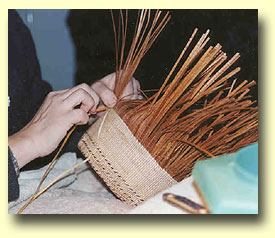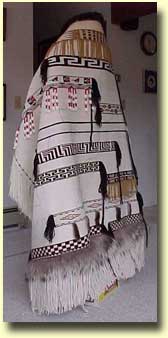
 |
 Basketry is in everyone's background, no matter where their ancestors may have
lived; you just have to go back far enough. The part that makes the
art unique is the materials used. This art form is a reflection of the
relationship we have with where we live.
Basketry is in everyone's background, no matter where their ancestors may have
lived; you just have to go back far enough. The part that makes the
art unique is the materials used. This art form is a reflection of the
relationship we have with where we live.Basketry of the Tlingit has a long history on the southeastern coast of Alaska... In the late 1990's several baskets emerged out of the mud just south of Sitka, AK. Several of the baskets were carbon dated at 4,780 years old plus or minus 60 years. The materials were roots of spruce and hemlock, split and prepared in the same way we do it today. The structural and edge techniques are methods we still use today. The continuity of weaving over 5,000 years is humbling. The baskets where and still are used on the coast for gathering, and storage. Before contact with the explorers and traders, they were also used for such things as drinking cups and cooking baskets.
With the introduction of pots, and pottery, the more utilitarian style baskets were no longer needed. The focus of weavers was on items for sale or trade. The late 1800's and early 1900's was a transition into a market economy, baskets were one of the largest contributors during this time period. Most of the baskets in museums and private collections today were purchased during this relatively short time. These large old baskets today are still the main competition for the present day weavers, most of which are not Tlingit. Materials used in Tlingit baskets are spruce roots primarily, some cedar bark, and for the designs maidenhair fern and grass. The methods are twining and plaiting.
 Raven's
Tail is a method of twining with Mountain Goat wool. These Robes
and regalia pieces were prestige's garments seen by the early explores
and collected by Captain Cook, Malispina, and Russian Officers. They
were found in the northern region of the Tlingit, originally called
"Northern Geometric Chilkat". The weaving died out in the 1600 and 1700's.
With a few old pieces collected in the very early 1800's. It returned
to the coast in 1989. Cheryl Samuel taught several classes in southeast
Alaska. She had spent several years traveling the world with a grant
to write a book about our weaving. Without her research it may have
been many years before the weaving would return home. She still teaches
the weaving today.
Raven's
Tail is a method of twining with Mountain Goat wool. These Robes
and regalia pieces were prestige's garments seen by the early explores
and collected by Captain Cook, Malispina, and Russian Officers. They
were found in the northern region of the Tlingit, originally called
"Northern Geometric Chilkat". The weaving died out in the 1600 and 1700's.
With a few old pieces collected in the very early 1800's. It returned
to the coast in 1989. Cheryl Samuel taught several classes in southeast
Alaska. She had spent several years traveling the world with a grant
to write a book about our weaving. Without her research it may have
been many years before the weaving would return home. She still teaches
the weaving today. We will never know why the weaving of Raven's Tail robes stopped on the coast, or why Chilkat Robes took the place of the Raven's Tail Robes. We could speculate --- Fashion? Time and Materials? The wool blankets, buttons, and beads brought in by the millions on trade ships? After several generations the knowledge would be lost with no examples to reference...
Today much of the regalia is woven with Merino wool. It is available, and processed for easier use in the weaving. The warp is leg spun on the thigh with lots of water to set the spin and ply. Robes take anywhere from 600 to 2,000 hours. The raw materials to start a Robe cost the weaver $1,000.00 to $2,000.00. Most of the robes and regalia created today are on commission; museums, public spaces and a few private collectors. The native community is making every effort to use the more traditional regalia, but the cost makes it very difficult. As we start to weave with the Mountain Goat again, the Raven's Tail is once again becoming a relationship between Natives of southeast Alaska, and the natural elements of home.
Raven's Tail is defined as a geometric twine (using two and three strands. in horizontal and vertical techniques) with design elements similar to basketry. The leg spun warp was traditionally of mountain goat wool and hair. The name "Raven's Tail" is a name first used by Canadian weaver Cheryl Samuel, and does not refer to an affiliation with any clan. It speaks of the long tassels seen on the Robes; it has become the recognized name today. We do not know the traditional Tlingit name because it was gone for too many generations.
Chilkat weaving originated from the "People of the Nass (River)" according to oral tradition. This would be the Tsimshian. The Chilkat differs from Raven's Tail in it's structure, of solid twine, the technique allows the weaver to create curves and circles. One of the other indicators is the presents of yellow cedar in the leg spun warp with the mountain goat wool and hair. Chilkat is an area of southeast Alaska were this kind of weaving was still practiced during the time the Traders frequented the coast. The traders themselves used this name it became recognized and is used still today.
about
the artist :: installations
and exhibits :: basketry :: weavings
history :: purchases
:: links :: contact
us :: home
Web site ©copyright 2002-2007 by Teri Rofkar
| Web design by Hudson Hudson
This site was created to share information about Alaskan Native arts and artists,
Alaskan Native basketry and basketweaving, Ravenstail weaving, Northwest Coast
spruce root baskets, Northwest Coast cedar bark baskets, pine needle basketry,
American Indian crafts, and the work of Tlingit Indian artist Teri Rofkar from
Southeast Alaska. Please feel free to print out any of the information on this
web site for your personal use. We welcome links to Teri's web site.
Alaskan basketry, Alaska weaving, weavers, basket makers, basketmakers, Northwest Coast, North West Coast, baskets, Alaskan baskets, Indian basketry, Tlingit basket makers, Tlingit Indian artists, Alaskan crafts, Alaska basketry, Southeast Alaska, artists, craftsmen, spruce root baskets, cedar bark baskets, Ravenstail, Alaskan basket art